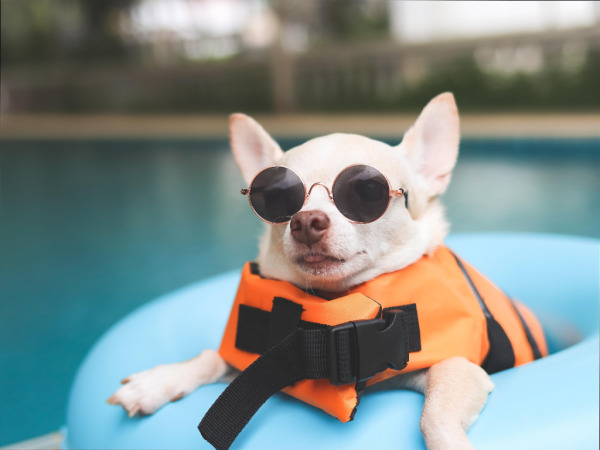Do All Dogs Know How to Swim?
The image of a dog gracefully paddling through water is a classic one, but it might surprise you to learn that not all dogs are natural swimmers! While some breeds take to water like ducks and enjoy water based canine enrichment, others may find themselves floundering. Swimming is a great way to keep your dog cool in the summer, but if not done correctly it could prove to be dangerous for your dog. Let’s dive into the facts about dogs and swimming, along with essential safety tips for both you and your furry friend.
Natural Swimmers vs. Land Lovers
Many assume that all dogs are born with an innate ability to swim. However, this isn’t entirely true. Here’s a quick breakdown:
Natural Swimmers: Breeds like Labradors, Golden Retrievers, and Newfoundlands often excel in the water. These dogs have strong, muscular builds, webbed feet, and an affinity for water, making them natural-born swimmers.
Land Lovers: Breeds such as Bulldogs, Pugs, and Dachshunds may struggle in the water. Their physical characteristics, such as short legs, heavy bodies, or flat faces, can make swimming difficult and even dangerous.
Teaching Your Dog to Swim
If your dog isn’t a natural swimmer, don’t worry! With patience and positive reinforcement, most dogs can learn to enjoy the water and benefit from the water enrichment. Here are some tips to help your pup paddle with confidence:
- Start Slow: Introduce your dog to water gradually. Begin with shallow areas where your dog can stand and feel secure.
- Use a Life Jacket: Invest in a high-quality dog life jacket, especially for breeds that aren’t natural swimmers. This provides buoyancy and helps keep your dog safe.
- Positive Reinforcement: Use treats, toys, and praise to encourage your dog. Make swimming a fun and rewarding experience.
- Supervise Closely: Never leave your dog unattended around water. Even experienced swimmers can get into trouble.
Safety First: Tips for Water Adventures
Whether you’re at the beach, pool, or lake, water safety is paramount. Here are some essential safety tips to ensure a fun and safe experience for you and your dog:
- Watch for Fatigue: Swimming is strenuous exercise, and dogs can tire quickly. Keep swim sessions short and provide plenty of breaks.
- Be Mindful of Water Conditions: Avoid strong currents, rough waves, and extremely cold water, as these can pose risks to your dog.
- Rinse After Swimming: Chlorine, saltwater, and freshwater lakes can irritate your dog’s skin and coat. Rinse your dog thoroughly with fresh water after swimming.
- Know the Signs of Trouble: Watch for signs of distress, such as frantic paddling, struggling to stay afloat, or trying to climb on you for support. If you see any of these signs, help your dog out of the water immediately.
- Teach an Exit Strategy: Ensure your dog knows how to exit the water safely, whether it’s a pool ladder, a dock ramp, or a gently sloping shoreline.
So, do all dogs know how to swim? The answer is no, but with the right approach and safety measures, most dogs can learn to enjoy the water. Whether your dog is a natural swimmer or a tentative toe-dipper, always prioritize safety to ensure that water adventures are fun and stress-free for both of you.
At the UltiMutt Inn, we love dogs and want to keep them safe. Remember, a happy, safe pup makes for the best swimming companion. Now, grab that doggy life jacket and head to the nearest body of water for some splashy summer fun! Happy paddling! 🐾

